Husqvarna 96193005200, 924HV User Manual
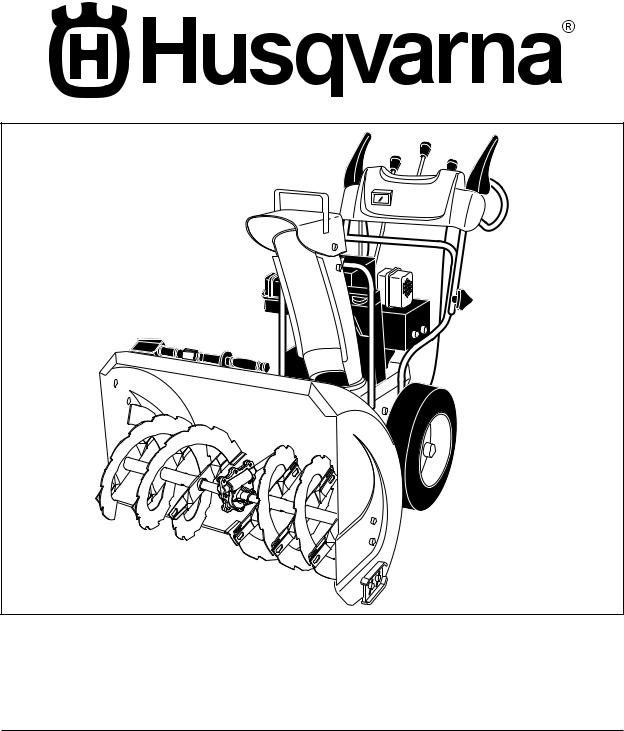
924HV
Operator's Manual
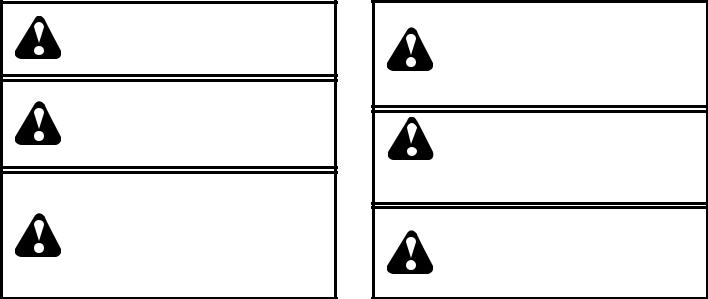
IMPORTANT
Safe Operation Practices for Walk-Behind Snow Throwers
This snow thrower is capable of amputating hands and feet and throwing objects. Failure to observe the following safety instructions could result in serious injury.
Look for this symbol to point out important safety precautions. It means CAUTION!!! BECOME ALERT!!! YOUR SAFETY IS INVOLVED.
WARNING: Always disconnect spark plug wire and place it where it cannot contact plug in order to prevent accidental starting when setting up, transporting, adjusting or making repairs.
WARNING: This snow thrower is for use on sidewalks, driveways and other ground level surfaces. Caution should beexercisedwhileusingonslopingsurfaces. Do not use snow thrower on surfaces above ground level such as roofs of residences, garages, porches or other such structures or buildings.
WARNING: Snow throwers have exposed rotating parts, which can cause severe injury from contact, or from material thrown from the discharge chute. Keep the area of operation clear of all persons, small children and pets at all times including startup.
CAUTION: Muffler and other engine parts become extremely hot during operation and remain hot after engine has stopped. To avoid severe burns on contact, stay away from these areas.
WARNING: Engine exhaust, some of its constituents, and certain vehicle components contain or emit chemicals known to the State of California to cause cancer and birth defects or other reproductive harm.
Training
1.Read, understand and follow all instructions on the machine and in the manual(s) before operating this unit. Be thoroughly familiar with the controls and the proper use of the equipment. Know how to stop the unit and disengage the controls quickly.
2.Never allow children to operate the equipment. Never allow adults to operate the equipment without proper instruction.
3.Keep the area of operation clear of all persons, particularly small children.
4.Exercise caution to avoid slipping or falling, especially when operating the snow thrower in reverse.
Preparation
1.Thoroughly inspect the area where the equipment is to be used and remove all doormats, sleds, boards, wires, and other foreign objects.
2.Disengage all clutches and shift into neutral before starting the engine (motor).
3.Do not operate the equipment without wearing adequate winter garments. Avoid loose fitting clothing that can get caught in moving parts. Wear footwear that will improve footing on slippery surfaces.
4.Handle fuel with care; it is highly flammable
(a)Use an approved fuel container.
(b)Never add fuel to a running engine or hot engine.
(c)Fill fuel tank outdoors with extreme care. Never fill fuel tank indoors.
(d)Never fill containers inside a vehicle or on a truck or trailer bed with a plastic liner. Always place containers on the ground, away from your vehicle, before filling.
(e)When practical, remove gas-powered equipment from the truck or trailer and refuel it on the ground. If this is not possible, then refuel such equipment on a trailer with a portable container, rather than from a gasoline dispenser nozzle.
(f)Keep the nozzle in contact with the rim of the fuel tank or container opening at all times, until refueling is complete. Do not use a nozzle lock-open device.
(g)Replace gasoline cap securely and wipe up spilled fuel.
(h)If fuel is spilled on clothing, change clothing immediately.
5.Use extension cords and receptacles as specified by the manufacturer for all units with electric drive motors or electric starting motors.
6.Adjust the collector housing height to clear gravel or crushed rock surface.
7.Never attempt to make any adjustments while the engine (motor) is running (except when specifically recommended by manufacturer).
8.Always wear safety glasses or eye shields during operation or while performing an adjustment or repair to protect eyes from foreign objects that may be thrown from the machine.
Operation
1.Do not put hands or feet near or under rotating parts. Keep clear of the discharge opening at all times.
2.Exercise extreme caution when operating on or crossing gravel drives, walks, or roads. Stay alert for hidden hazards or traffic.
3.After striking a foreign object, stop the engine (motor), remove the wire from the spark plug, disconnect the cord on electric motors, thoroughly inspect the snow thrower for any damage, and repair the damage before restarting and operating the snow thrower.
4.If the unit should start to vibrate abnormally, stop the engine (motor) and check immediately for the cause. Vibration is generally a warning of trouble.
5.Stop the engine (motor) whenever you leave the operating position, before unclogging the collector/impeller housing or discharge chute, and when making any
2 |
repairs, adjustments or inspections. |
|
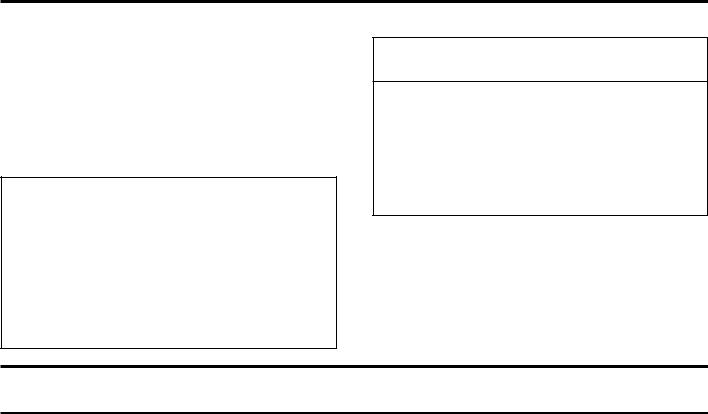
6.Whencleaning,repairingorinspectingthesnowthrower, stop the engine and make certain the collector/impeller and all moving parts have stopped. Disconnect the spark plug wire and keep the wire away from the plug to prevent someone from accidentally starting the engine.
7.Do not run the engine indoors, except when starting the engine and for transporting the snow thrower in or out of the building. Open the outside doors; exhaust fumes are dangerous.
8.Exercise extreme caution when operating on slopes.
9.Never operate the snow thrower without proper guards, and other safety protective devices in place and working.
10.Never direct the discharge toward people or areas where property damage can occur. Keep children and others away.
11.Do not overload the machine capacity by attempting to clear snow at too fast a rate.
12.Never operate the machine at high transport speeds on slippery surfaces. Look behind and use care when operating in reverse.
13.Disengage power to the collector/impeller when snow thrower is transported or not in use.
14.Use only attachments and accessories approved by the manufacturer of the snow thrower (such as wheel weights, counterweights, or cabs).
15.Never operate the snow thrower without good visibility or light. Always be sure of your footing, and keep a firm hold on the handles. Walk; never run.
16.Never touch a hot engine or muffler.
Clearing a Clogged Discharge Chute
Hand contact with the rotating impeller inside the discharge chute is the most common cause of injury associated with snow throwers. Never use your hand to clean out the discharge chute. To clear the chute:
1.SHUT THE ENGINE OFF!
2.Wait 10 seconds to be sure the impeller blades have stopped rotating.
3.Always use a clean-out tool, not your hands.
Maintenance and Storage
1.Check shear bolts and other bolts at frequent intervals for proper tightness to be sure the equipment is in safe working condition.
2.Never store the machine with fuel in the fuel tank inside a building where ignition sources are present such as hot water heaters, space heaters, or clothes dryers. Allow the engine to cool before storing in any enclosure.
3.Always refer to operator’s manual for important details if the snow thrower is to be stored for an extended period.
4.Maintain or replace safety and instruction labels, as necessary.
5.Run the machine a few minutes after throwing snow to prevent freeze-up of the collector/impeller.
CONGRATULATIONS on your purchase of a new snow thrower. It has been designed, engineered and manufactured to give best possible dependability and performance.
Should you experience any problem you cannot easily remedy, please contact your nearest authorized service center. We have competent, well-trained technicians and the proper tools to service or repair this unit.
Please read and retain this manual. The instructions will enable you to assemble and maintain your snow thrower properly. Always observe the “SAFETY RULES”.
SERIAL NUMBER: ___________________________
DATE OF PURCHASE: _______________________
THE MODEL AND SERIAL NUMBERS WILL BE FOUND ON A DECAL ATTACHED TO THE REAR OF THE SNOW THROWER HOUSING.
YOU SHOULD RECORD BOTH SERIAL NUMBER AND DATE OF PURCHASE AND KEEP IN A SAFE PLACE FOR FUTURE REFERENCE.
PRODUCT SPECIFICATIONS
Gasoline Capacity 0.5 Gallons (1,89 Liters) and Type: Unleaded Regular only
Oil Type |
SAE 30 (above 50°F) |
(API SG–SL): |
SAE 5W-30 or 10W-30 (32° to 50°F) |
|
SAE 5W-30 (below 32°F) |
|
|
Oil Capacity: |
20 Ounces (0,57 Liters) |
|
|
Spark Plug: |
Champion RN9YC |
Gap: |
0.030" (0,762 mm) |
CUSTOMER RESPONSIBILITIES
•Read and observe the safety rules.
•Follow a regular schedule in maintaining, caring for and using your snow thrower.
•Follow the instructions under “Maintenance” and “Storage” sections of this owner’s manual.
TABLE OF CONTENTS
SAFETY RULES ........................................................ |
2-3 |
PRODUCT SPECIFICATIONS...................................... |
3 |
CUSTOMER RESPONSIBILITIES................................ |
3 |
ASSEMBLY / PRE-OPERATION ............................... |
4-7 |
OPERATION ............................................................ |
8-13 |
MAINTENANCE SCHEDULE ..................................... |
14 |
MAINTENANCE..................................................... |
14-15 |
SERVICE AND ADJUSTMENTS........................... |
16-18 |
STORAGE................................................................... |
19 |
TROUBLESHOOTING................................................ |
20 |
WARRANTY............................................... |
BACK PAGE |
3

PARTS PACKED SEPARATELY IN CARTON
(1) POWER CORD |
(1) MULTI- |
(3) RETAINER |
|
(198563) |
|||
WRENCH |
SPRINGS |
||
|
|||
|
(180684) |
(169675) |
|
(2) SHEAR BOLTS 1/4-20 x 1-3/4 |
(2) LOCKNUTS |
|
|
|
1/4-20 |
|
|
(192090) |
|
|
|
|
(73800400) |
|
|
|
|
|
(2) FLAT WASHERS |
|
|
|
|
SAFTEY |
|
|
|
IGNITION KEY (S) |
|
|
|
(422663) |
|
|
(2) CARRIAGE BOLTS |
(1) LOCKNUT |
(1) CARRIAGE BOLT |
|
3/8-16 x 2.25 |
5/16-18 |
|
5/16-18 x 5/8 |
|
(751153) |
|
(72250505) |
|
(1) WASHER 3/8 |
(1) LOCKNUT 3/8 |
(1) LOCKNUT |
(1) SHOULDER |
|
|
(2) HANDLE KNOBS |
1/4-20 |
BOLT 1/4-20 |
(1) SPRING |
|||
(19131316) |
(73800600) |
(191730) |
(179829) |
(184505) |
||
|
ASSEMBLY / PRE-OPERATION
Read these instructions and this manual in its entirety before you attempt to assemble or operate your new snow thrower. Reading the entire manual will familiarize you with the unit, which will assist you in assembly, operation and maintenance of the product.
Your new snow thrower has been assembled at the factory with the exception of those parts left unassembled for shipping purposes. All parts such as nuts, washers, bolts, etc., necessary to complete the assembly have been placed in the parts bag. To ensure safe and proper operation of your snow thrower, all parts and hardware you assemble must be tightened securely. Use the correct tools as necessary to ensure proper tightness.
REMOVE SNOW THROWER FROM CARTON
1.Remove all accessible loose parts and parts boxes from carton.
2.Cut down all four corners of carton and lay panels flat.
3.Remove the two (2) screws securing the auger housing to the pallet.
4.Remove all packing materials except plastic tie holding speed control rod to lower handle.
5.Remove the two (2) plastic ties securing the upper handle to the pallet.
6.Remove snow thrower from carton and check carton thoroughly for additional loose parts.
HOW TO SET UP YOUR SNOW THROWER
TOOL BOX (See Fig. 10)
A toolbox is provided on your snow thrower. The toolbox is located on top of the belt cover. Store the extra shear bolts, nuts and multi-wrench provided in parts bag in the toolbox.
4
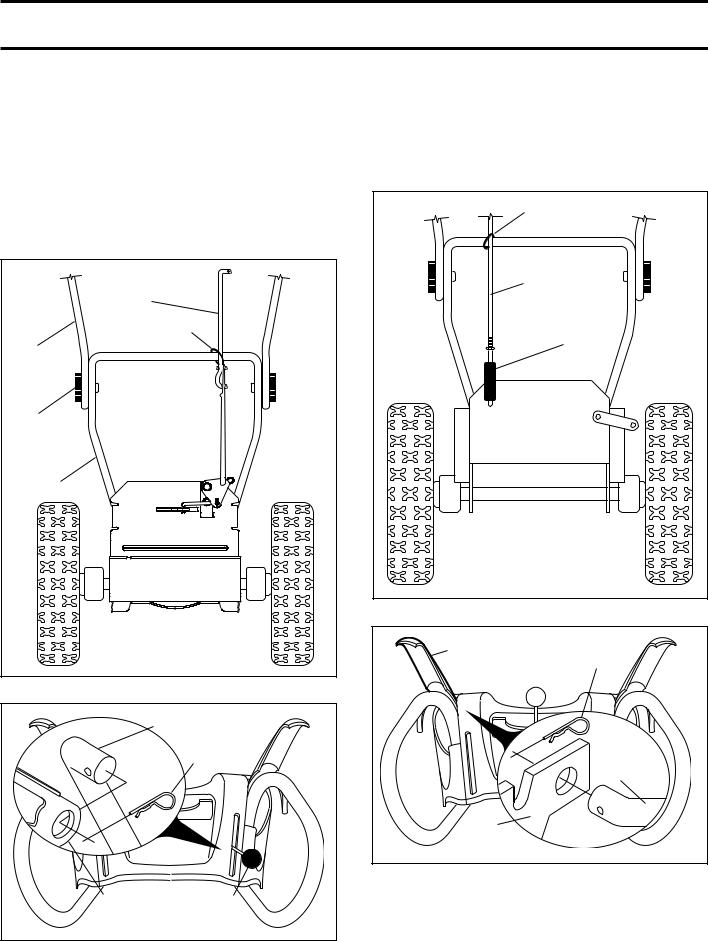
ASSEMBLY / PRE-OPERATION
NOTE: The multi-wrench may be used for assembly of the chute rotator head to snow thrower and making adjustments to the skid plates.
UNFOLD UPPER HANDLE
1.Raise upper handle to the operating position and tighten handle knobs securely. Additional carriage bolts, washers and handle knobs are in bag of parts. Use to secure upper handle to lower handle. Install in lower holes in handles.
INSTALL SPEED CONTROL ROD (See Figs. 1 and 2)
1.Remove plastic tie securing rod to lower handle.
2.Insert rod into speed control bracket and secure with retainer spring.
SPEED |
CONTROL |
ROD |
PLASTIC TIE |
UPPER |
HANDLE |
HANDLE |
KNOB |
LOWER |
HANDLE |
FIG. 1
SPEED CONTROL ROD |
|
|
RETAINER |
|
SPRING |
SPEED |
SPEED |
CONTROL |
CONTROL |
BRACKET |
LEVER |
FIG. 2
INSTALL TRACTION DRIVE CONTROL ROD (See Figs. 3 and 4)
The traction drive control rod is installed on the snow thrower.
1.Remove plastic tie securing rod to lower handle.
2.With top end of rod positioned under left side of control panel, push rod down and insert top end of rod into hole in drive control bracket. Secure with retainer spring.
PLASTIC TIE |
TRACTION DRIVE |
CONTROL ROD |
VINYL |
SLEEVE |
FIG. 3
TRACTION DRIVE |
RETAINER |
CONTROL LEVER |
SPRING |
|
TRACTION |
|
DRIVE |
|
CONTROL |
|
ROD |
DRIVE |
|
CONTROL |
|
BRACKET |
|
FIG. 4
5
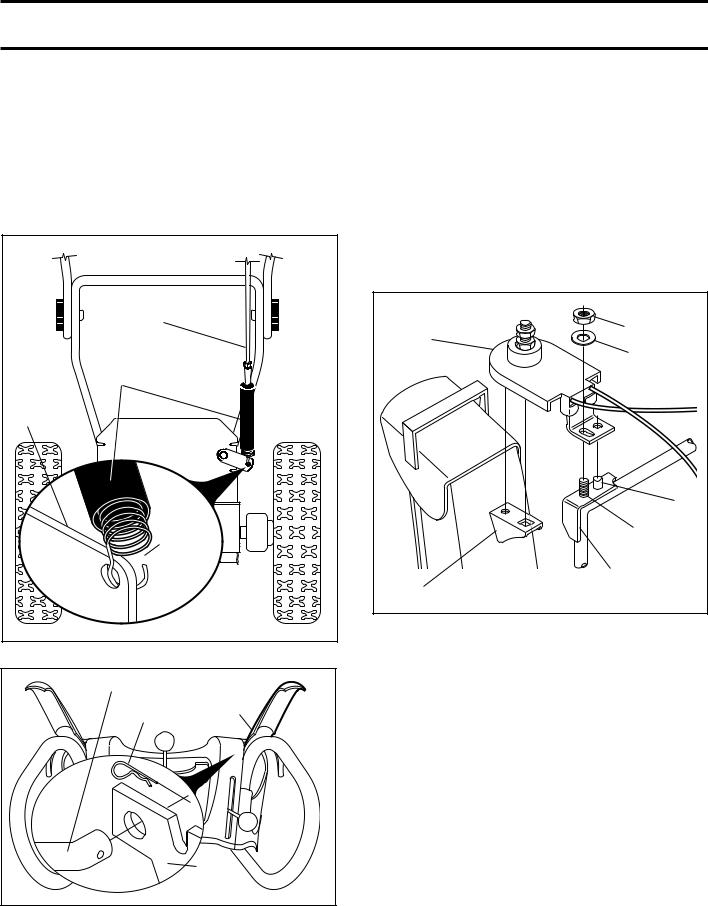
ASSEMBLY / PRE-OPERATION
INSTALL AUGER CONTROL ROD (See Figs. 5 and 6)
1.Retrieve vinyl sleeve and spring from bag of parts and retrieve the auger control rod from carton chute tray. Slide straight rod end through the small hole in the vinyl sleeve. Hook spring in hole in rod end.
2.Hook end of spring into control arm with loop opening up as shown. (See Fig. 5)
3.With top end of rod positioned under right side of control panel, push down on rod and insert end of rod into hole in auger control bracket. Secure with retainer spring.
AUGER |
CONTROL |
ROD |
VINYL |
SLEEVE |
CONTROL |
ARM |
LOOP |
OPENING |
UP |
FIG. 5
AUGER CONTROL ROD |
AUGER |
|
RETAINER |
CONTROL |
|
LEVER |
||
SPRING |
||
|
||
|
AUGER |
|
CONTROL |
||
BRACKET |
||
FIG. 6
INSTALL DISCHARGE CHUTE / CHUTE ROTATER HEAD (See Fig. 7)
NOTE: The multi-wrench provided in your parts bag may be used to install the chute rotater head.
1.Place discharge chute assembly on top of chute base with discharge opening toward front of snow thrower.
2.Position chute rotater head over chute bracket. If necessary,rotatechuteassemblytoalignsquareandpinonunderside of chute rotater head with holes in chute bracket.
3.With chute rotater head and chute bracket aligned, position chute rotater head on pin and threaded stud of mounting bracket.
4.Install 3/8 washer and locknut on threaded stud and tighten securely.
CHUTE |
|
|
ROTATER |
|
3/8 LOCKNUT |
HEAD |
|
|
|
|
3/8 WASHER |
|
|
PIN |
|
|
THREADED |
|
|
STUD |
|
ALIGN BEFORE |
ROTATER HEAD |
CHUTE |
MOUNTING |
|
BRACKET |
TIGHTENING LOCKNUT |
BRACKET |
FIG. 7
6
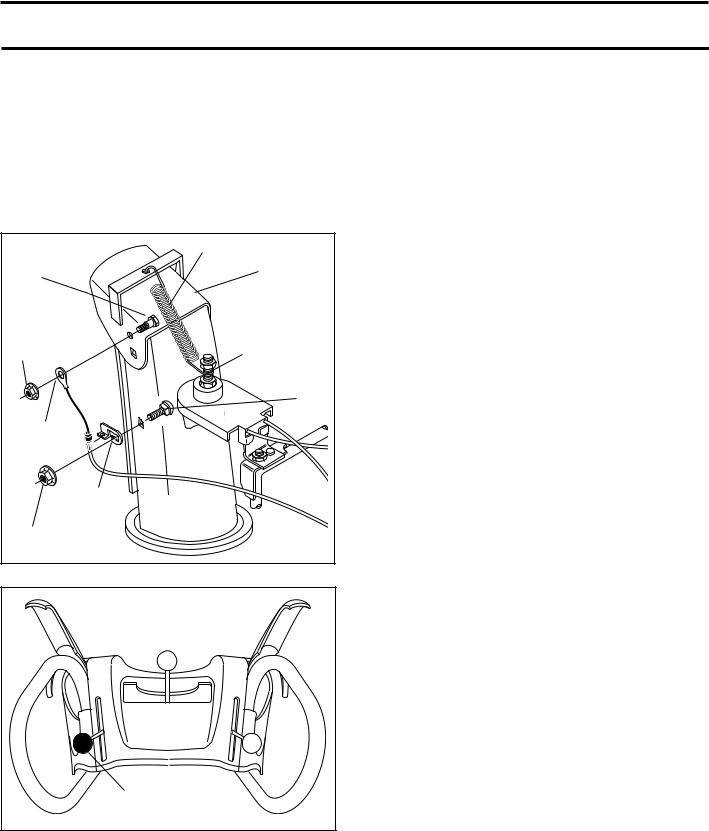
ASSEMBLY / PRE-OPERATION
INSTALL CHUTE DEFLECTOR REMOTE CONTROL
(See Figs. 8 and 9)
1.Install remote cable bracket to discharge chute with 5/16-18 carriage bolt and 5/16-18 locknut as shown. Tighten securely.
2.Install remote cable eyelet to chute deflector with 1/4-20 shoulder bolt and 1/4-20 locknut as shown. Tighten nut securely. Cable eyelet will be loose on shoulder bolt.
3.Install spring hooks between hex nuts on chute rotater head and into hole in chute deflector as shown.
1/4-20 |
SPRING |
|
CHUTE |
||
SHOULDER |
||
DEFLECTOR |
||
BOLT |
||
|
||
|
HOOK |
|
|
BETWEEN |
|
|
HEX NUTS |
|
|
ON CHUTE |
|
1/4-20 |
ROTATER |
|
LOCKNUT |
HEAD |
|
|
5/16-18 |
|
|
CARRIAGE |
|
|
BOLT |
|
CABLE |
|
|
EYELET |
|
|
REMOTE |
|
|
CABLE |
|
|
BRACKET |
|
|
5/16-18 |
|
|
LOCKNUT |
|
FIG. 8
CHUTE DEFLECTOR |
CONTROL LEVER |
FIG. 9
CHECK TIRE PRESSURE
The tires on your snow thrower were overinflated at the factory for shipping purposes. Correct and equal tire pressure is important for best snow throwing performance.
•Reduce tire pressure to 14-17 PSI.
7
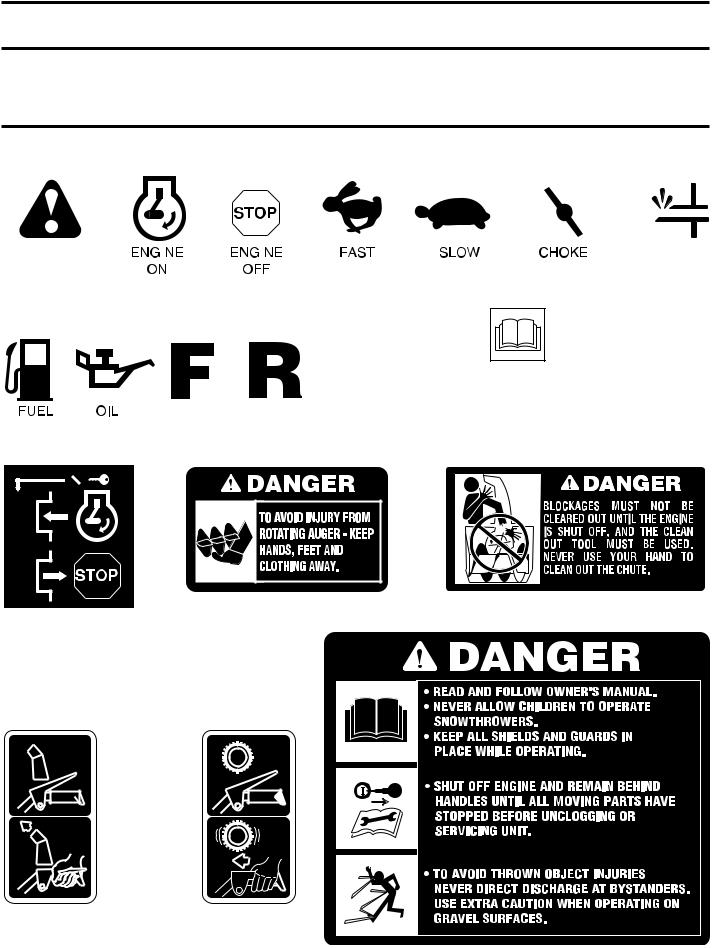
OPERATION
KNOW YOUR SNOW THROWER
READ THIS OWNER'S MANUAL AND ALL SAFETY RULES BEFORE OPERATING YOUR SNOW THROWER. Compare the illustrations with your snow thrower to familiarize yourself with the location of various controls and adjustments. Save this manual for future reference.
These symbols may appear on your snow thrower or in literature supplied with the product. Learn and understand their meaning.
DANGER |
|
|
|
|
|
|
|
|
|
PRIMER |
|
|
|
|
|
|
|
|
|
||
|
|
|
|
|
|
|
|
|
||
|
|
|
|
|
|
|
||||
|
|
|
||||||||
OR WARNING
READ AND FOLLOW ALL SAFETY INFORMATION
AND INSTRUCTIONS BEFORE USE OF THIS PRODUCT. FORWARD REVERSE KEEP THESE INSTRUCTIONS FOR FUTURE REFERENCE.
IGNITION KEY. |
|
INSERT TO START |
|
AND RUN, |
|
PULL OUT TO STOP. |
|
DISENGAGED |
|
ENGAGED |
|
SNOW |
TRACTION |
DISCHARGE |
DRIVE CONTROL |
|
8 |
